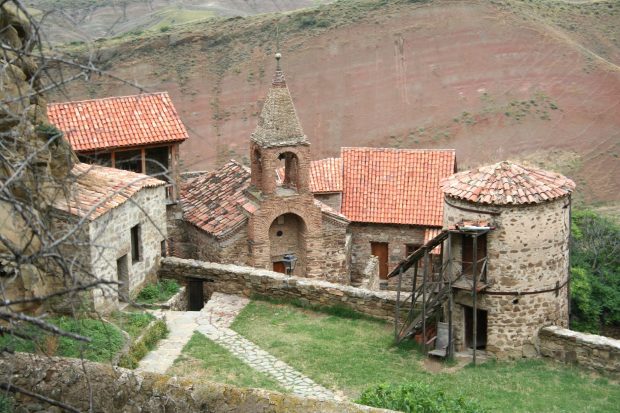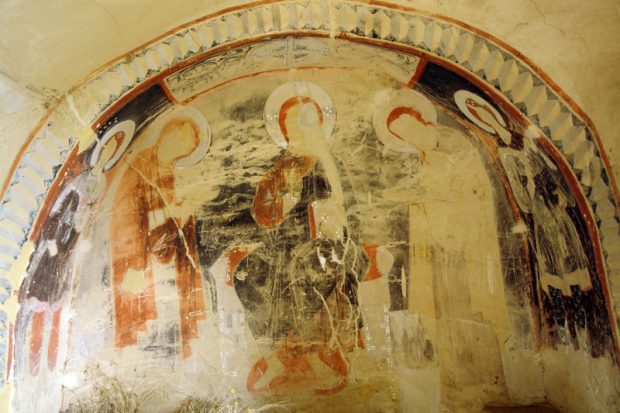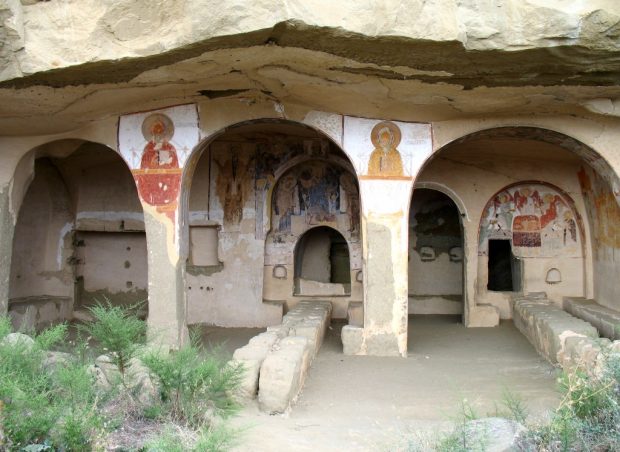Cultural Heritage of Georgia: Davit Gareja Cave Monastery
 On the border with Azerbaijan, the ancient monastery complex of Davit Gareja (or Gareji) is one of the most remarkable of Georgia’s historic sites. Its uniqueness is heightened by a lunar, semi-desert landscape that turns green and blooms with flowers in early summer. Davit Gareja comprises of about 15 monasteries spread over a remote area (most long abandoned), but visitors usually just see two – Lavra (which has been restored since Soviet times and is now again inhabited by monks) and, on the hill above it, Udabno, which has beautiful frescoes.
On the border with Azerbaijan, the ancient monastery complex of Davit Gareja (or Gareji) is one of the most remarkable of Georgia’s historic sites. Its uniqueness is heightened by a lunar, semi-desert landscape that turns green and blooms with flowers in early summer. Davit Gareja comprises of about 15 monasteries spread over a remote area (most long abandoned), but visitors usually just see two – Lavra (which has been restored since Soviet times and is now again inhabited by monks) and, on the hill above it, Udabno, which has beautiful frescoes.
 Lavra, the original monastery here, was founded by Davit Gareja, one of the 13 ascetic Syrian fathers who returned from the Middle East to spread Christianity in Georgia in the 6th century. The complex grew until monasteries were spread over a wide area. Manuscripts were translated and copied, and a celebrated school of fresco painting flourished here. The monasteries were destroyed by the Mongols in 1265, revived in the 14th century by Giorgi V the Brilliant, sacked by Timur, and then destroyed on Easter night 1615 when Shah Abbas’ soldiers killed 6000 monks and trashed many of the artistic treasures. The monasteries never regained their former importance, though they remained active until the end of the 19th century.
Lavra, the original monastery here, was founded by Davit Gareja, one of the 13 ascetic Syrian fathers who returned from the Middle East to spread Christianity in Georgia in the 6th century. The complex grew until monasteries were spread over a wide area. Manuscripts were translated and copied, and a celebrated school of fresco painting flourished here. The monasteries were destroyed by the Mongols in 1265, revived in the 14th century by Giorgi V the Brilliant, sacked by Timur, and then destroyed on Easter night 1615 when Shah Abbas’ soldiers killed 6000 monks and trashed many of the artistic treasures. The monasteries never regained their former importance, though they remained active until the end of the 19th century.
It wasn’t until the Bolshevik takeover in 1921 that the monastery was closed down and became deserted. During the late Soviet years, the monastery became a training ground for the Soviet War in Afghanistan and this caused considerable damage to the murals within the complex and caused a public outcry among Georgians. When Georgia restored its independence, the monastery was revived and now has once again, become a center of religious activity as well as an important destination for pilgrims and tourists alike. The inside of the cave structures has been covered with numerous artistic and colorful murals—a number of which have survived the test of time.
 Since the Soviet border-drawing process did not have any regard for cultural borders, especially when religious heritage was involved, today, parts of the monastery complex are technically located within Azerbaijan and this has sparked a minor border dispute between the two countries. Given the religious and cultural importance of Davit Gareja, Georgians have stated it to be unacceptable that the site would be split between two countries, and have offered a land swap, but a final agreement has yet to be achieved.
Since the Soviet border-drawing process did not have any regard for cultural borders, especially when religious heritage was involved, today, parts of the monastery complex are technically located within Azerbaijan and this has sparked a minor border dispute between the two countries. Given the religious and cultural importance of Davit Gareja, Georgians have stated it to be unacceptable that the site would be split between two countries, and have offered a land swap, but a final agreement has yet to be achieved.
It takes two to three hours to explore Lavra and Udabno. In July and August it can get fearfully hot here by the middle of the day, so an early start, getting here by 10 am, would be ideal.





















































